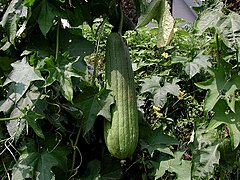Luffa
| Luffa subsp. var. | ||||||||||||||||||||||||||||||||||||||||||||||||||||||||
|---|---|---|---|---|---|---|---|---|---|---|---|---|---|---|---|---|---|---|---|---|---|---|---|---|---|---|---|---|---|---|---|---|---|---|---|---|---|---|---|---|---|---|---|---|---|---|---|---|---|---|---|---|---|---|---|---|

|
|
| ||||||||||||||||||||||||||||||||||||||||||||||||||||||
| ||||||||||||||||||||||||||||||||||||||||||||||||||||||||
The luffa, loofah, or lufah (from Arabic لوف) are tropical and subtropical vines comprising the genus Luffa. The fruit of at least two species, Luffa acutangula and Luffa aegyptiaca (Luffa cylindrica), is grown to be harvested before maturity and eaten as a vegetable, popular in Asia and Africa.
{{Inc| Luffa (luff is the Arabic name). Cucurbitaceae. Rag Gourd. Dish-Cloth Gourd. Vegetable Sponge. About 8 species of annual tendril-climbing herbs, inhabiting the tropics of the Old and New Worlds, mostly in the former. Lvs. 5-7-lobed: tendrils simple or multifid: fls. monoecious or dioecious, the staminate ones in a long-stalked raceme or cluster, the pistillate solitary and shorter-peduncled; calyx bell-shape or top-shape, strongly 5-lobed; corolla of 5 soft yellow or whitish petals, sometimes ragged-edged; stamens usually 3. borne in the calyx-tube: fr. a long, gourd-like, 3-celled pepo, becoming dry when ripe and the fibrous interior sponge-like. In the South it has been called "California okra."
The luffas have come into more or less prominence in American gardens, being an importation from the tropics, and China and Japan. In other countries, the fruit is eaten when young, being cooked like squash or served in soups and stews. The young fruit is sometimes sliced and dried. (See Georgeson. A. G., Sept., 1892, and Bailey, Bull. 67, Cornell Exp. Sta.) In this country, luffas are grown mostly for curiosity and ornament. The fibrous interior of the dried fruit, when bleached and prepared, is used as a sponge for the bath and for scrubbing (whence "vegetable sponge"). The culture is the same as for cucumbers and melons. They are tender plants, running 10 to 15 feet. The luffas are widely dispersed in the tropics as cultivated plants. The genus divides itself into two groups,—those species (L. cylindrica and L. acutangula) with fruits not spiny or tuberculate, and those with spiny fruits. }
Cultivation
Propagation
Pests and diseases
Species
- Luffa acutangula (Angled Luffa, Ridged Luffa, Vegetable Gourd)
- Luffa aegyptiaca / Luffa cylindrica (Smooth Luffa, Egyptian Luffa, Dishrag Gourd, Sponge Gourd Loofa)
- Luffa operculata (Wild Loofa, Sponge Cucumber)
Gallery
If you have a photo of this plant, please upload it! Plus, there may be other photos available for you to add.
A bag of natural luffas on an organic farm.
A luffa sponge whose coarse texture helps with skin polishing.
References
- Standard Cyclopedia of Horticulture, by L. H. Bailey, MacMillan Co., 1963



